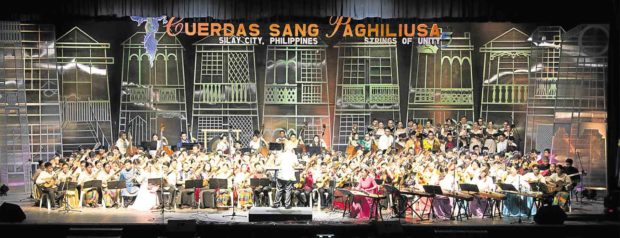
Because they valued cultural heritage, Silay, Negros Occidental locals were thankful that the National Commission for Culture and the Arts (NCCA) chose their quaint city to host the International Rondalla/Plucked String Music Festival 2018.
NCCA mounted the festival with the Asian Composers League of the Philippines and Silay City Government. The fifth edition of the unique festival was called “Cuerdas Sang Paghiliusa,” which means “Strings of Unity.”
Over 250 performers from different parts of the world converged in Silay on Nov. 3-11. Plucked string artists from the Philippines were invited to showcase their talents alongside selected musicians from Uganda, Portugal, South Korea and Thailand and six other groups from abroad.
“Silay is a highly cultured place and it should have been one of the first venues for this Rondalla Festival,” National Artist for Music and festival director Ramon P. Santos said. “The people here respond very much to the concert. We are making a mark here in Silay.”
Silay is not called “Paris of Negros” for nothing. The city became a home for European musicians and artists during the Spanish era. It has produced important Filipino singers such as Isang Tapales and Jovita Fuentes and Conchita Gaston.
During the eight-day run of the festival, concerts, exhibits, school visits and outreach performances were packed with people.
In the final concert at the Natalio G. Velez Sports and Cultural Center, the Festival Ensemble, composed of the participating local and international musicians, played “The Visayan Medley No. 2,” arranged and conducted by Santos. It incorporated three songs from the region—“Pispis Ngabukaw,” “Ahay Kalisud” and “Dalawidaw.”
Composer-conductor Chino Toledo, soprano Stafanie Quintin, and the Festival Ensemble graced the final concert.
Kabataan Silay Rondalla Ensemble conductor Jegger Anjao said the rondalla tradition was alive and well in Silay. “It is a big thing that they chose Silay to be the host of this year’s festival. People here appreciate the rondalla and the exposure given to our musicians is a great experience.”
Silay’s famous ancestral houses from the Spanish period play a part in cultivating culture and tradition, he said.
“Culturally speaking, children here grow up seeing the ancestral houses and the value of great appreciation is instilled in their hearts, he added. “That’s why it was not hard for me teaching (rondalla) because they value tradition.”
Heritage houses
Musicians were not just able to visit the Spanish-era structures, they even performed in the German Unson, Hofileña and Pitong Ledesma ancestral houses.
Over 30 houses in Silay have been declared historical landmarks. Some are still being used as residences while some have been converted into museums and tourist attractions.
Foreign musicians joined the tour. “It was a nice trip looking at these houses. We don’t have this thing called ‘ancestral houses’ in Uganda and I don’t know how we can best compare with what we have back home,” Matavu Lawrence of Hop Africa Uganda said.
Other popular heritage houses are Balay Negrense, and the Bernardino Jalandoni, Teodoro Morada and Jose Conteza Locsin houses.
Solomon Locsin said that families owning heritage houses were very keen at their proper restoration and conservation. They are glad to share the history and grandeur of these houses to the public, he added.
“We are still using these houses and we like telling the stories,” Locsin said. “It was beautiful when the musicians from the Rondalla Festival went here to play their music.”
“Rondalla is our heritage, it’s our patrimony,” Santos declares. “We got that from Spain but we sort of modified it into our very own performing ensemble so it expresses our feelings, it expresses our emotions so you can’t take anything away from that.” –CONTRIBUTED